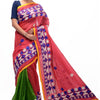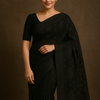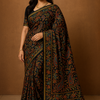How Many Types of Kantha Stitches Are There?

Kantha stitching is a beautiful embroidery style from Bengal, India, and Bangladesh. It’s known for intricate designs that bring fabrics to life. There are several types of Kantha stitches, each adding unique textures and beauty to sarees, quilts, and garments. Let’s explore these different stitches and what makes each one special.
- Running Stitch
- Description: This is the most basic Kantha stitch. It’s made of small, even stitches, creating a quilted effect on fabric.
- Uses: Running stitch is commonly used for outlining patterns on sarees and making simple quilts, giving them an elegant look.
- Darning Stitch
- Description: The darning stitch is dense and solid, perfect for filling in patterns with bold, textured areas.
- Uses: This stitch is ideal for intricate designs in nakshi Kantha, which often tell stories with beautiful motifs.
- Dorukha (Double-Sided) Stitch
- Description: This stitch is unique because it appears on both sides of the fabric, requiring high skill.
- Uses: Dorukha is often used in reversible sarees and shawls, giving a two-in-one design that’s perfect for wearing both sides.
- Lik (Writing) Kantha
- Description: Lik Kantha creates detailed, drawn-like designs that can look like sketches on fabric.
- Uses: This stitch is great for creating images of animals, flowers, and stories. It’s popular in wall hangings and decorative sarees.
- Cross-Stitch (Chatai) Kantha
- Description: Similar to regular cross-stitch, Chatai Kantha makes a pattern that looks like a basket weave.
- Uses: This sturdy stitch is used for borders on sarees and for items like blankets and pillow covers.
- Lohori (Wave) Kantha
- Description: Lohori stitch has wavy lines that look like water ripples, creating a soft, flowing look.
- Uses: Perfect for bedspreads, blankets, and wall hangings, giving a peaceful, nature-inspired touch.
- Anund (Circular) Kantha
- Description: This stitch makes circles and spiral patterns, adding movement and depth to fabric.
- Uses: Commonly used in quilt centerpieces, saree borders, and wall hangings, Anund Kantha symbolizes unity and eternity.
Wrapping Up
Each type of Kantha stitch adds its own charm to fabrics, from the simple Running Stitch to the detailed Dorukha and Lik stitches. These stitches are not just designs; they are stories and history woven into fabric. Whether used in sarees, quilts, or wall hangings, Kantha stitching captures the beauty and heritage of Bengal.
The Art of Creating a Kantha Stitch Saree
Kantha stitch sarees are one of the most treasured textiles from Bengal, India, and Bangladesh. The intricate, handwoven designs of Kantha stitch sarees tell stories, depict cultural symbols, and celebrate traditional artistry. Let’s explore the step-by-step process of creating a Kantha saree and how different stitches and designs impact its beauty.
Step-by-Step Process of Creating a Kantha Stitch Saree
- Selecting the Fabric
- The process begins with choosing a high-quality fabric, typically lightweight cotton or silk, which provides a smooth base for intricate hand embroidery. Cotton is ideal for casual wear, while silk is often chosen for more formal sarees.
- Planning the Design
- Kantha designs range from simple geometric patterns to detailed images depicting nature, mythology, or village life. Artisans sketch out these designs directly on the fabric or work from memory, carefully planning motifs that align with the saree's borders and pallu (the decorative end).
- Starting the Stitching
- Artisans use various Kantha stitches, each adding unique textures and depth. They begin with a Running Stitch, the most basic Kantha style, which lays the foundation. This stitch is often used to outline designs, creating a quilted effect across the fabric.
- Adding Layers with Different Stitches
- As the stitching progresses, different types of Kantha stitches are used to fill and highlight designs. Common stitches include:
- Darning Stitch: For dense, solid areas that stand out within the design, adding texture and dimension.
- Dorukha (Double-Sided) Stitch: Adds design to both sides of the saree, often for reversible patterns.
- Cross-Stitch (Chatai): Used for filling larger motifs with a basket weave effect.
- Detailing with Fine Stitches
- Smaller motifs and intricate details are added with fine stitches, such as Lik (Writing) Kantha, which creates delicate, pen-like effects. This is typically used for depicting nature, animals, and cultural stories within the design.
- Creating the Borders
- Kantha sarees often have elaborate borders to frame the artwork within. Borders can feature simpler, repetitive stitches or more complex patterns to match the central designs. The borders add a finished, cohesive look to the saree.
- Quality Check and Finishing Touches
- After stitching is complete, the saree is inspected to ensure quality and uniformity. Loose threads are trimmed, and the saree is gently ironed to highlight the texture. The completed saree is ready for wear, a blend of tradition, artistry, and intricate handwork.
How Stitch Types and Designs Impact the Overall Aesthetic
Each type of stitch used in Kantha embroidery plays a specific role, contributing to the saree’s final look and feel. Here’s how:
- Running Stitch: This foundational stitch is subtle but creates a quilted, wavy texture that adds depth without overwhelming the design. It’s perfect for minimalist sarees with smaller, spaced-out motifs.
- Darning Stitch: With its dense, solid feel, the darning stitch makes patterns bold and noticeable. It’s ideal for creating focal points, adding an embossed look to sarees intended for special occasions.
- Dorukha (Double-Sided) Stitch: This stitch adds versatility, making the saree reversible with designs on both sides. Dorukha sarees are practical and stylish, offering two looks in one.
- Cross-Stitch (Chatai): Cross-stitch Kantha creates a textured, basket weave effect that’s eye-catching and durable. This stitch is often used for decorative borders and filling in large areas, creating a dynamic contrast with more delicate stitches.
- Lik Kantha (Writing Stitch): Lik Kantha gives sarees a delicate, hand-drawn look, ideal for story-telling designs and intricate motifs like flowers and animals. It adds a sense of culture and detail that makes each saree unique.
Conclusion
Creating a Kantha stitch saree is a labor of love and a true art form. From selecting the fabric to layering intricate stitches, each step requires patience, skill, and creativity. The choice of stitches, motifs, and design style come together to create a wearable masterpiece that reflects the beauty and heritage of Bengal. Whether simple or elaborate, each Kantha saree is a one-of-a-kind artwork crafted with timeless skill.






